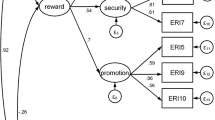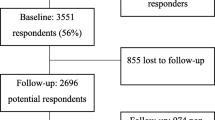Abstract
Purpose
To examine cross-sectional and longitudinal associations between content-related emotional demands at work and exhaustion, and to investigate if these associations were modified by other psychosocial work characteristics.
Methods
In 2007, 4489 Danish public service employees participated in the PRISME study by completing postal questionnaires, and 3224 participated in the follow-up in 2009. Content-related emotional demands were measured by a scale (scored 1 to 5) based on five work-content-related items, and exhaustion was measured with the general exhaustion scale from the Copenhagen Burnout Inventory (CBI) (scored 1 to 5). The cross-sectional and longitudinal associations with exhaustion were analysed in the same model and adjusted for effects of potential confounders. Effect modifications were examined separately for self-reported emotional enrichment, meaningful work, job control, social support at work and quantitative demands.
Results
Exhaustion increased with increasing emotional demands, both cross-sectionally and longitudinally. However, although statistically significant, the effect was small. In the longitudinal analysis, a one unit increase in emotional demands was associated with a 0.03 unit (95% CI: 0.01–0.06) increase in exhaustion. We found statistically significant effect modification for three of six potentially modifying work characteristics. The effect of emotional demands on exhaustion was lower for participants with high levels of emotional enrichment (cross-sectionally and longitudinally), high levels of meaningful work (longitudinally), and higher for high levels of quantitative demands (cross-sectionally).
Conclusions
Increasing content-related emotional demands were associated with increasing levels of exhaustion, cross-sectionally and longitudinally. This effect was reduced if the work was experienced as emotionally enriching and meaningful.
Similar content being viewed by others
References
Agius RM, Blenkin H, Deary IJ, Zealley H, Wood RA (1996) Survey of perceived stress and work demands of consultant doctors. OEM 53:217–224
Arnold BB, Demerouti E (2007) The job demands-resources model: state of the art. J Manag Psycho 22(3):309–328
Aronsson G, Theorell T, Grape T, Hammarström A, Hogstedt C, Skoog I, Träskman-Bendz L, Hall C (2017) A systematic review including meta-analysis of work environment and burnout symptoms. BMC Public Health 17:264. https://doi.org/10.1186/s12889-017-4153-7
Bakker AB, Demerouti E (2016) Job demands-resources theory: Taking stock and looking forward. J Occup Health Psychol 22(3):273–285
Bakker AB, Demerouti E, Euwema MC (2005) Job Resources Buffer the Impact of Job Demands on Burnout. J Occup Health Psychol 10(2):170–180
Bianchi R, Schonfeld IS, Laurent E (2015) Burnout-depression overlap: a review. Clin Psychol Rev 36:28–41. https://doi.org/10.1016/j.cpr.2015.01.004
Borritz M. Burnout in human service work—causes and consequences (2006c) Ph.D. thesis. National Institute of Occupational Health, Denmark
Borritz M, Bultmann U, Rugulies R, Christensen KB, Villadsen E, Kristensen TS (2005) Psychosocial work characteristics as predictors for burnout: findings from 3-year follow up of the PUMA Study. J Occup Environ Med 47(10):1015–1025
Borritz M, Rugulies R, Bjorner JB, Villadsen E, Mikkelsen OA, Kristensen TS (2006a) Burnout among employees in human service work: design and baseline findings of the PUMA study. Scand J Public Health 34(1):49–58
Borritz M, Rugulies R, Christensen KB, Villadsen E, Kristensen TS (2006b) Burnout as a predictor of self-reported sickness absence among human service workers: prospective findings from three year follow up of the PUMA study. Occup Environ Med 63(2):98–106
Brand S, Beck J, Hatzinger M, Harbaugh A, Ruch W, Holsboer-Trachsler E (2010) Associations between satisfaction with life, burnout-related emotional and physical exhaustion, and sleep complaints. World J Biol Psychiatry 11(5):744–754
Brugha T, Bebbington P, Tennant C, Hurry J (1985) The List of Threatening Experiences: a subset of 12 life event categories with considerable long-term contextual threat. Psychol Med 15(1):189–194
Cho SH, Park M, Jeon SH, Chang HE, Hong HJ (2014) Average Hospital Length of Stay, Nurses’ Work Demands, and Their Health and Job Outcomes. J Nurs Scholarsh 46(3):199–206
Christensen KS, Fink P, Toft T, Frostholm L, Ornbøl E, Olesen F (2005) A brief case-finding questionnaire for common mental disorders: the CMDQ. Fam Pract 22:448–457
De Jonge J, Mulder MJ, Nijhuis FJ (1999) The incorporation of different demand concepts in the job demand-control model: effects on health care professionals. Soc Sci Med 48(9):1149–1160. https://doi.org/10.1016/j.ijnurstu.2007.11.002
De Jonge J, Le Blanc PM, Peeters MC, Noordam H (2008) Emotional job demands and the role of matching job resources: a cross-sectional survey study among health care workers. Int J Nurs Stud 45(10):1460–1469
Demerouti E, Bakker AB, Nachreiner F, Schaufeli WB (2001) The job demands-resources model of burn-out. J Appl Psychol 86:499–512
Eysenck HJ, Eysenck SBG (1975) Manual of the eysenck personality Questionnaire. Hodder & Stoughton, London
Fitzmaurice GM, Laird NM, Ware JH (2012) Fixed effects versus random effects models. In: Fitzmaurice GM, Laird NM, Ware JH Applied Longitudinal Analysis. John Wiley & Sons, Hoboken
Freimann T, Merisalu E (2015) Work-related psychosocial risk factors and mental health problems amongst nurses at a university hospital in Estonia: A cross-sectional study. Scand J Public Health 43(5):447–452. https://doi.org/10.1177/1403494815579477
Frese M, Zapf D (1988) Methodological issues in the study of work stress: objective vs. subjective measurement of work stress and the question of longitudinal studies. In: Cooper CL, Payne R (eds) Causes, coping and consequences of stress at work. Wiley, Chichester, pp 375–411
Grandey A (2000) Emotion regulation in the workplace: a new way to conceptualize emotional labor. J Occup Health Psychol 5:95–110. https://doi.org/10.1037//1076-8998.5.1.95
Grynderup MB, Mors O, Hansen ÅM, Andersen JH, Bonde JP, Kærgaard A et al (2013) Work-unit measures of organisational justice and risk of depression—a 2-year cohort study. Occup Environ Med 70(6):380–385. https://doi.org/10.1136/oemed-2012-101000
Huynh JY, Xanthopoulou D, Winefield AH (2013) Social support moderates the impact of demands on burnout and organizational connectedness: a two-wave study of volunteer firefighters. J Occup Health Psychol 18:9–15. https://doi.org/10.1037/a0030804
Idris MA, Dollard MF, Yulita (2014) Psychosocial safety climate, emotional demands, burnout, and depression: a longitudinal multilevel study in the Malaysian private sector. J Occup Health Psychol 19(3):291–302. https://doi.org/10.1037/a0036599
Kaerlev L, Kolstad HA, Hansen AM, Thomsen JF, Kaergaard A, Rugulies R et al (2011) Are risk estimates biased in follow-up studies of psychosocial factors with low base-line participation? BMC Public Health 11:539. https://doi.org/10.1186/1471-2458-11-539
Kim IH, Noh S, Muntaner C (2013) Emotional demands and the risks of depression among homecare workers in the USA. Int Arch Occup Environ Health 86(6):635–644. https://doi.org/10.1007/s00420-012-0789-x
Kolstad HA, Hansen AM, Kærgaard A, Thomsen JF, Kaerlev L, Mikkelsen S et al (2011) Job Strain and the Risk of Depression: Is Reporting Biased? Am J Epidemiol 173(1):94–102. https://doi.org/10.1093/aje/kwq318
Kozak A, Kersten M, Schillmoller Z, Nienhaus A (2013) Psychosocial work-related predictors and consequences of personal burnout among staff working with people with intellectual disabilities. Res Dev Disabil 34(1):102–115
Kristensen TS, Borritz M, Villadsen E, Christensen KB (2005a) The Copenhagen Burnout Inventory: A new tool for the assessment of burnout. Work Stress 19(3):192–207. https://doi.org/10.1080/02678370500297720
Kristensen TS, Hannerz H, H›gh A, Borg V (2005b) The Copenhagen Psychosocial Questionnaire—a tool for the assessment and improvement of the psychosocial work environment. Scand J Work Environ Health 31(6):438–449
Lorente Prieto L, Salanova Soria M, Martínez Martínez IM, Shaufeli W (2008) Extension of the Job Demands- Resources model in the prediction of burnout and engagement among teachers over time. Psicothema 20(3):354–360
Madsen IE, Diderichsen F, Rugulies R (2010) Person-related work and incident use of antidepressants: relations and mediating factors from the Danish work environment cohort study. Scand J Work Environ Health 36(6):435–444. https://doi.org/10.5271/sjweh.3049
Mohren DCL, Swaen GMH, Kant I, van Amelsvoort LGPM, Borm PJA, Galama JMD (2003) Common infections and the role of burnout in a Dutch working population. J Psychosom Res 55(3):201–208
Pejtersen J, Kristensen TS, Bjorner JB, Borg V, Christensen KB (2010) The second version of the Copenhagen Psychosocial Questionnaire. Scand J Public Health 2010;38(suppl 3):8–24. https://doi.org/10.1177/1403494809349858
Peng K, Peng KZ, Wong C, Che H, Peng C, Wong H (2010) The missing link between emotional demands and exhaustion. J Manag Psychol 25(7):777–798
Poghosyan L, Aiken LH, Sloane DM (2014) Corrigendum to “Factor structure of the Maslach burnout inventory: an analysis of data from large scale cross-sectional surveys of nurses from eight countries”. Int J Nurs Stud 51(10):1416–1417
Schaufeli WB (1998) The burnout companion to study and practice, a critical analysis. Taylor & Francis, London
Seidler A, Thinschmidt M, Deckert S, Then F, Hegewald J, Nieuwenhuijsen K, Riedel-Heller SG (2014) The role of psychosocial working conditions on burnout and its core component emotional exhaustion – a systematic review. J Occup Med Toxicol 9:10. https://doi.org/10.1186/1745-6673-9-10
Söderfeldt M (1997) Burnout? School of Social Work, Lund University
Sundin L, Hochwalder J, Bildt C, Lisspers J (2007) The relationship between different work-related sources of social support and burnout among registered and assistant nurses in Sweden: a questionnaire survey. Int J Nurs Stud 44(5):758–769. https://doi.org/10.1016/j.ijnurstu.2006.01.004
Sundin L, Hochwalder J, Lisspers J (2011) A longitudinal examination of generic and occupational specific job demands, and work-related social support associated with burnout among nurses in Sweden. Work 38(4):389–400. https://doi.org/10.3233/WOR-2011-1142
Taris TW, Schreurs PJ (2009) Explaining worker strain and learning: how important are emotional job demands? Anxiety Stress Coping 22(3):245–262. https://doi.org/10.1080/10615800802460401
Tuxford LM, Bradley GL (2015) Emotional job demands and emotional exhaustion in teachers. Educational Psychology 35(8):1006–1024. https://doi.org/10.1080/01443410.2014.912260
Vammen MA, Mikkelsen S, Hansen AM, Bonde JP, Grynderup MB, Kolstad H et al (2016) Emotional demands at work and the risk of clinical depression: a longitudinal study in the danish public sector. J Occup Environ Med 58(10):994–1001. https://doi.org/10.1097/JOM.0000000000000849
Van Vegchel N, de Jonge J, Söderfeldt M, Dormann C, Schaufeli W (2004) Quantitative Versus Emotional Demands Among Swedish Human Service Employees: Moderating Effects of Job Control and Social Support. Int J Stress Manag 11(1):21–40. https://doi.org/10.1037/1072-5245.11.1.21
Van de Ven B, van den Tooren M, Vlerick P (2013) Emotional job resources and emotional support seeking as moderators of the relation between emotional job demands and emotional exhaustion: a two-wave panel study. J Occup Health Psychol 18(1):1–8. https://doi.org/10.1037/a0030656
Van Der Ploeg E, Kleber R (2003) Acute and chronic job stressors among ambulance personnel: predictors of health symptoms. Occup Environ Med 60:40–46
Ware JH, Dockery DW, Louis TA, Xu XP, Ferris BG Jr, Speizer FE (1990) Longitudinal and cross-sectional estimates of pulmonary function decline in never-smoking adults. Am J Epidemiol 132(4):685–700
Wolfgang AP (1988) Job stress in the health professions: a study of physicians, nurses, and pharmacists. Behav Med 14(1):43–47
Funding
The PRISME study was supported by an unrestricted research grant from the Danish Working Environment Research Fund and Lundbeck A/S.
Author information
Authors and Affiliations
Corresponding author
Ethics declarations
Conflict of interest
Marianne Agergaard Vammen was funded by Lundbeck A/S. Lundbeck A/S was not involved in any parts of the study or the preparation of the article. Jane Frølund Thomsen is appointed by the Danish National Board of Health to the Committee of Occupational Diseases, an advisory committee for the Danish National Board of Industrial Injuries.
Ethical standards
The study protocol was approved by the local Scientific Ethical Committee (RRS 2006-1028) and the Danish Protection Agency (2009-41-3215). Informed consent was obtained from all individual participants included in the study. All procedures performed in the study were in accordance with the ethical standards of the institutional research committee and with the 1964 Helsinki declaration and its later amendments or comparable ethical standards.
Additional information
Publisher’s Note
Springer Nature remains neutral with regard to jurisdictional claims in published maps and institutional affiliations.
Electronic supplementary material
Below is the link to the electronic supplementary material.
Rights and permissions
About this article
Cite this article
Vammen, M.A., Mikkelsen, S., Forman, J.L. et al. Emotional demands and exhaustion: cross-sectional and longitudinal associations in a cohort of Danish public sector employees. Int Arch Occup Environ Health 92, 639–650 (2019). https://doi.org/10.1007/s00420-018-01398-w
Received:
Accepted:
Published:
Issue Date:
DOI: https://doi.org/10.1007/s00420-018-01398-w




